In partnership with RSS.com
Best AI tools for podcasts
These tools are here to help you enhance the quality of your podcast

If you have been involved in podcast production over the past 20 years, you have probably seen things evolve from basic audio uploads to high fidelity, high bitrate, and super productions. The effort involved in podcasting has increased considerably, from pre-production considerations to ensuring the audio mastering in post-production meets the expected standard.
Something has to give, which is hopefully where AI tools come in. No software exists that is going to create a unique and compelling podcast discussion (although some come close), but plenty of AI software is available to streamline almost every element of the process.
AI tools can deal with a range of tasks, from the repetitive and boring (e.g. handling social media promotion, and generating transcriptions) to producing audio and music effects. AI can be used to generate voices and improve audio quality. You can also rely on artificial intelligence trained on Large Language Models to help analyze audience data.
These tools can help you streamline your podcasting workflow, improve the quality of your content, and reach a wider audience.
Get a full free month on Rss.com
Starting a successful podcast requires the right tools. RSS.com makes it simple to start, grow, track, and monetize a new podcast. With unlimited audio, distribution to top podcast apps like Spotify and Apple Podcasts, AI-powered episode transcriptions, and audio-to-video conversion for YouTube Podcasts, you'll have everything you need to succeed in podcasting. Sign up for free today and claim a full FREE month using coupon code TECHRADARFREE.
AI-powered podcast tools
Podcastle.ai

A platform that aims to “democratize access to podcasting,” Podcastle (not to be confused with the fantasy podcast of the same name) aims to streamline the process of podcasting with a simplified workflow of intelligent tools.
Podcastle provides a browser-based (Chrome only) recording environment, designed to support easy recording of audio, uploading of existing audio, and speech generation. It also gives you a virtual studio, where participants can be invited and recorded in the cloud. This supports audio-only and video podcasts.
For editing, scripts can be written or pasted and an AI voice used to create the podcast (or section). Meanwhile, editing can be performed by removing sections of text from a transcription, rather than selecting portions of audio.
Are you a pro? Subscribe to our newsletter
Sign up to the TechRadar Pro newsletter to get all the top news, opinion, features and guidance your business needs to succeed!
Other features in Podcastle include automatically remixing an audio track to improve the sound quality. This has a number of uses, from making voices distinct from noisy background audio to making the recording sound as if it were conducted in a studio.
Four plans are available with Podcastle. The free plan should be enough to get started, but pro podcasters might prefer the Storyteller (£143.90 annual billing) or Pro (287.90 annual billing) packages. These add AI audio editing, transcription, unlimited cloud storage, and AI-generated episode summaries, among many other features. Paid accounts also get access to the iOS app for mobile podcasting.
Speechify

Founded by Cliff Weitzman as a tool to “turn anything into an audiobook,” Speechify offers creators a collection of AI voices.
This is one of the most complete AI podcast tools, suitable for audio and video podcasts alike. There is an AI voice-over feature, AI video, AI transcription, AI dubbing, and even AI presentations. Unsurprisingly, Speechify has an AI voice cloning tool, which can be trained to replicate your voice. This can be done by recording a voice sample in the browser app or uploading a file of you speaking.
Speechify is also capable of providing translations of the text you provide, with the ability to convert text to speech in English, Hindi, and Spanish. Everything is organized in a standard editing timeline, or in an interface that resembles slideshow creation software.
The free option for Speechify will give you a good look at the software, but subscribing to the Basic ($69/month) or Professional ($99/month) enables various degrees of voice-over generation, dubbing, and access to licensed soundtracks and stock media. The Pro option also includes unlimited voice cloning and AI avatar generation. An Enterprise option takes all of these features to the max; prices for that option are only available upon request.
(Note that there is a separate Speechify app listening to text in whatever voice you want to use. These range from generated voices to celebrities. Gwyneth Paltrow, Snoop Dogg, and YouTubers Mr Beast and Ali Abdaal are the famous voices you can choose from, but none of these are available to you as a creator.)
Riverside.fm

Riverside (which relies on the Chrome browser) has a wealth of impressive tools, many of which rely on AI technologies. The AI voice tool lets you use text to speed with your own cloned voice, the clean-up feature lets you edit a podcast using the transcription, rather than the timeline (enabling easier removal of filler) and you can add captions to video clips with a single click. Riverside also gives your audio a boost with its Magic Audio, an AI tool that makes your podcast sound like you recorded it in a studio. You can also get AI-generated show notes, automated transcription, and a collection of Magic Clips for sharing on social media.
Riverside is available to use for free, but this option is limited to two hours of multi-track audio, at 44.1kHz audio bitrate, and 720p video. You also get unlimited single-track editing, Magic Clips, video calls for recording, and live streaming on social media. That’s not bad, but paid options ramp things up with a $15/month Standard option that brings things to high-quality audio and 4K video, or Pro for $24/month, which is where the AI voice, transcriptions, and show notes become available. A Business-level package is also available, with prices available on request.
Descript
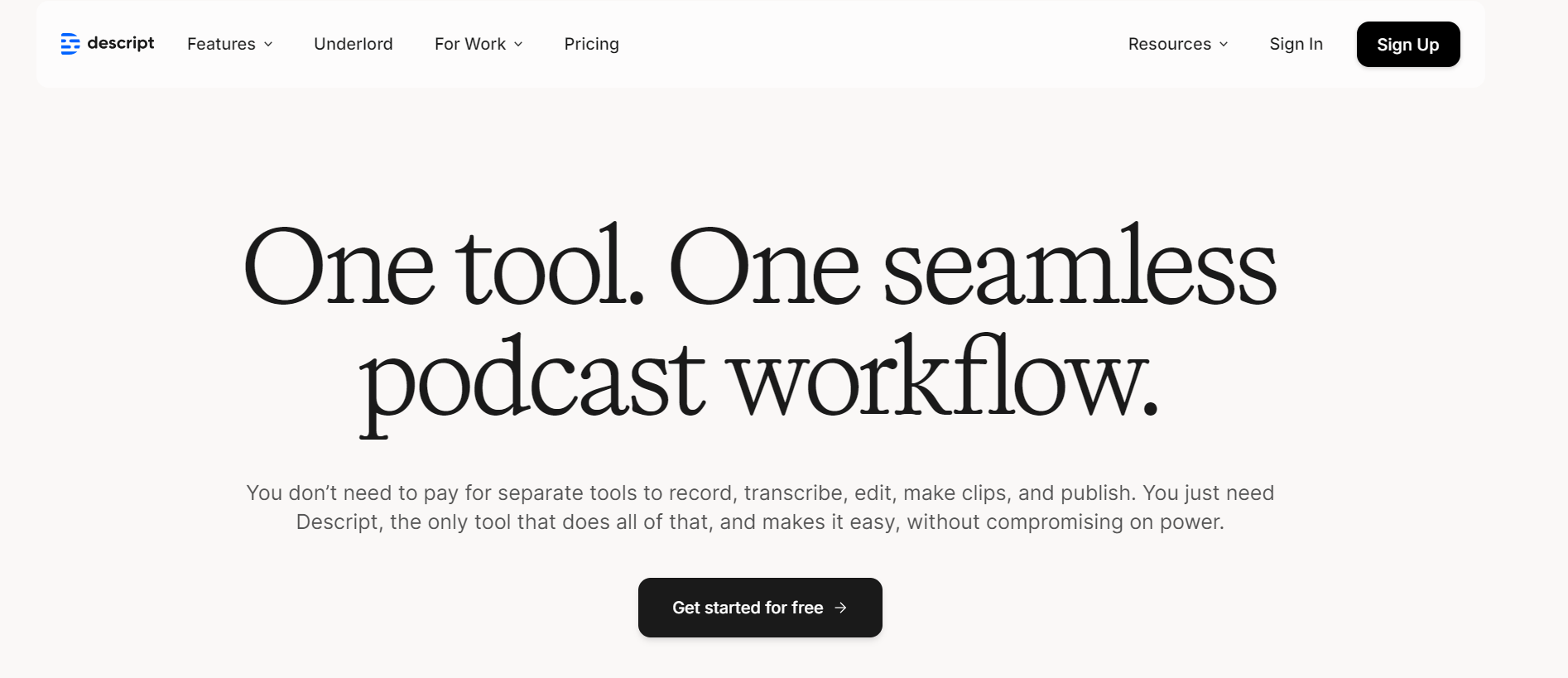
Another tool that combines an editing interface with AI tools, Descript is suitable for video and audio podcasting projects. The software is based on the concept of “if you can edit text…,” which highlights the strength of Descript. You can make podcasts, viral clips, and edit videos just using the text interface.
Descript is split into two main panes, with the text interface on the left and the media/timeline on the right. To get started, you simply upload the audio or video podcast and wait for the transcription. Once that appears, you can begin editing. Removing text removes the associated audio, so it’s a good idea to keep in mind how this might look in a video, and plan some B-roll clips to cover up any sudden changes in the subject’s pose.
Other AI features in Descript include AI-powered speech cloning, a viral clip creator, AI captioning, and even a tool that makes it look as though you are looking at the camera when you’re actually reading. You can also find translation tools, and a studio sound feature to remove unwanted noise and create polished audio. For videos recorded in untidy areas, there’s an AI green screen tool, too.
Descript is available as a browser-based app (it works best in Chrome and Edge) or as a desktop app on Windows and Mac. Along with the free plan (1 transcription hour/month, export video at 720p with watermarks, basic AI features, 5 minutes of AI speech), you can sign up for three paid tiers. $19/month Hobbyist gives you 10 transcription hours/month, 1080p watermark-free exports, 20 uses/month of the AI tools, and 30 minutes/month of AI speech, plus access to the stock media library.
The Creator package is $35/month with 30 transcription hours/month, 4K exports, unlimited AI tool use, 120 minutes/month of AI speech, and advanced export options. The Business tier is $50/month, and gives you 40 transcription hours/month, unlimited AI suite access, and 300 hours/month of AI speech, plus the ability to add collaborators. Savings are available with annual billing.
AI-powered voice generators
Resemble
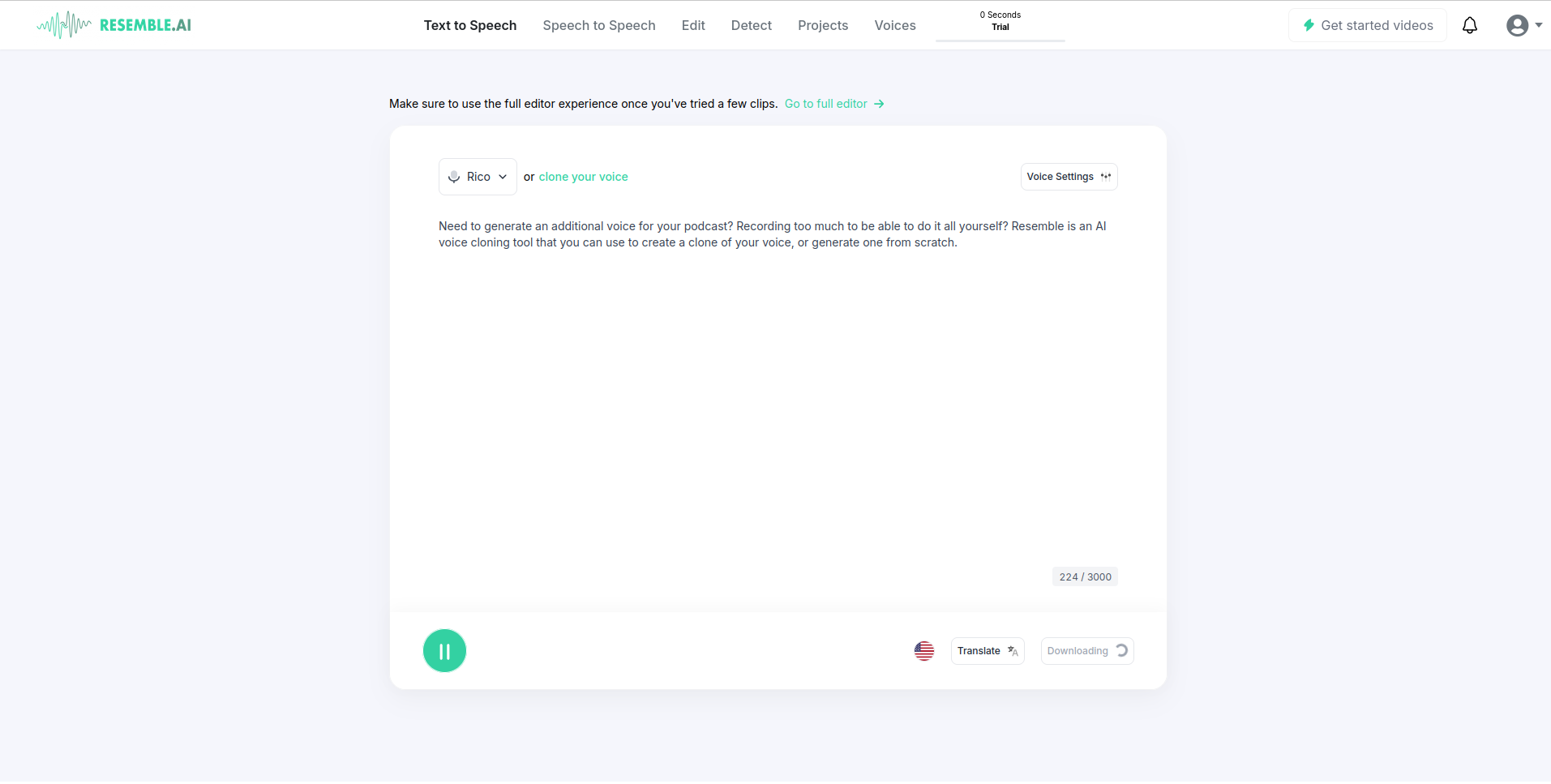
Need to generate an additional voice for your podcast? Recording too much to be able to do it all yourself? Resemble is an AI voice cloning tool that you can use to create a clone of your voice or generate one from scratch.
The process is simple: write the dialogue, paste it into the Text to Speech tool, and select a voice. If the voices on offer don’t suit, you can create your own. Resemble includes an editing tool, as well as providing an AI voice detection service to Enterprise customers.
Resemble is $29/month for the Creator plan (1 pro clone), $99/month for the Pro plan (3 pro clones), and $499/month for the Business plan (10 pro voice clones). All plans come with an increasing number of rapid clones, monthly time limits, audio editing, and more. As mentioned, there is an Enterprise plan, with quotes customized for specific projects.
ElevenLabs
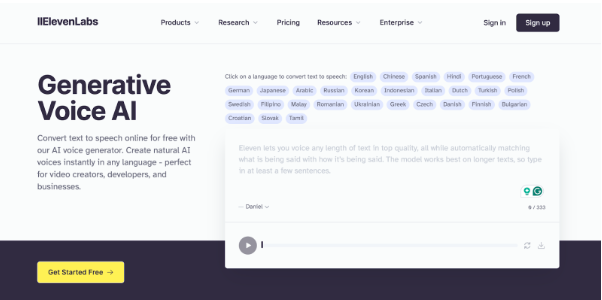
Another way to generate voices is with ElevenLabs. This is an AI-powered voice tool that you might use to narrate trailers, appear as a “guest” in your podcast (perhaps you need some dialogue reading in a different voice), or utilize its key feature, voice cloning.
By uploading a sample of you (or a colleague, preferably with their permission) ElevenLabs can create a clone of your voice, like this, which can be programmed to say pretty much anything you want.
This example sounds a lot like me, although I am not American. However, with more training audio, and ElevenLab’s built-in adjustment tools, you can get a reliable match of your own voice.
You can use ElevenLabs free, although you can only create around 10 minutes of generated or cloned audio with that plan. Alternatively, sign up for $5 a month for 30 minutes, $22 a month for 2 hours, or $99 for 10 hours.
AI-powered music and sound effects
Soundly
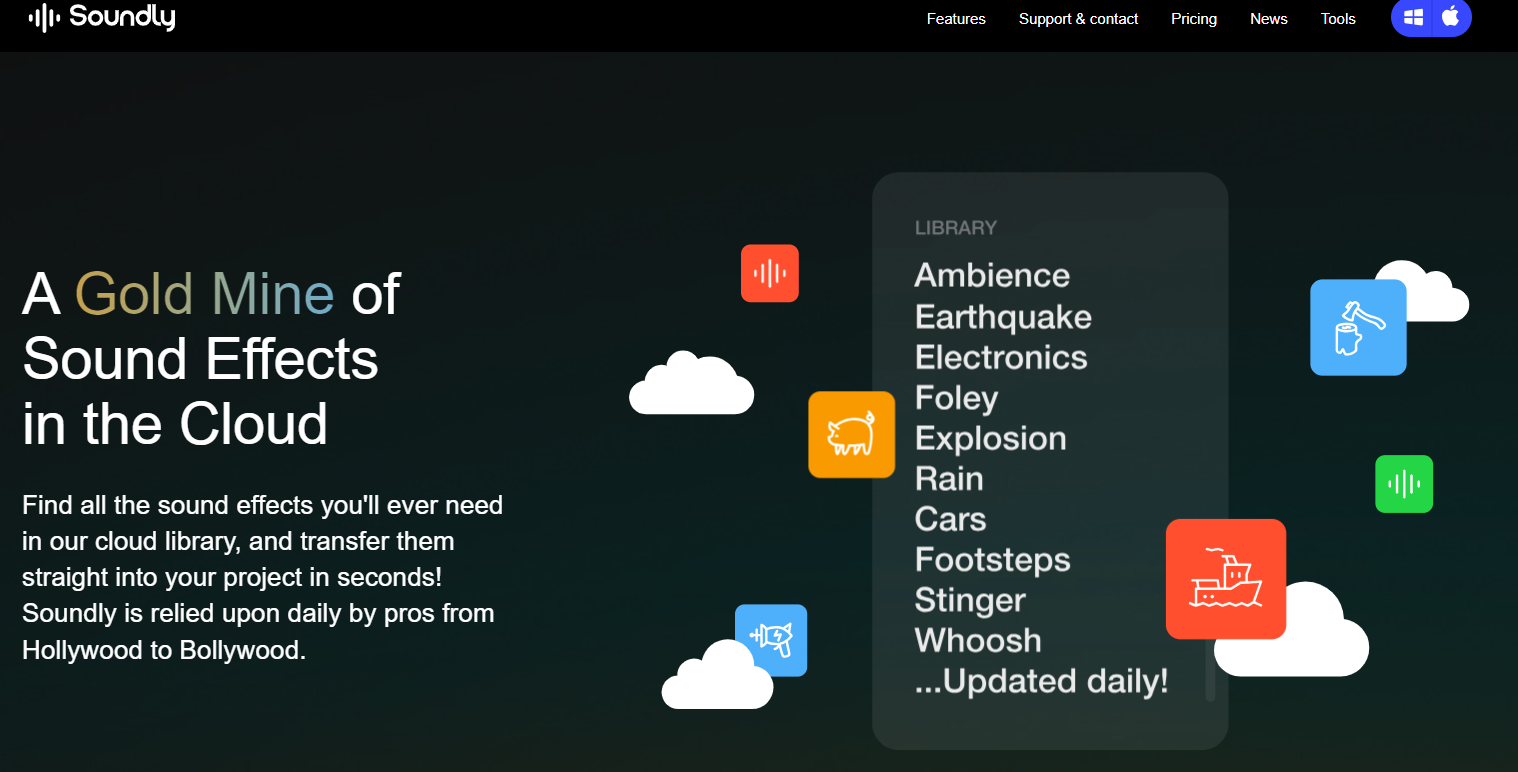
A searchable repository of royalty-free sound effects and music, Soundly uses AI in two ways. The first is part of the search tool, which combines artificial intelligence with related searches, auto-complete, and knowledge of its curated collections to help you find the sound you’re looking for.
Soundly’s second AI option is its Voice Designer tool. This lets you create voices that can simulate real-world background speech – airport announcements, TV commentary, navigation tools, etc. Once generated, these can be placed in different audio environments, and output through a selection of emulated speakers. All of the usual audio formats are supported, and Soundly has integrations with
Pro Tools, Logic, Premiere, Nuendo, Cubase, Reaper, After Effects, Wwise, and other suites.
Unlike many other tools in this list, Soundly is a desktop app, available for Windows and Mac. It can be used with a free plan, with access to the Soundly free library, and gives you 25 voice designer renders. The paid option is $14.99/month, with access to Soundly’s Pro library, unlimited voice renders, and 10GB of cloud storage. If you’re working on something short-term and need access for a few hours, there is also a 24-hour option for a flat $9.99.
Artlist

Intended for audio and video podcasting (as well as other video creators), Artlist gives you sound effects, music, and footage, all licensed through a monthly subscription. These assets are selected using AI, based on a prompt you provide, and can then be added manually to an artboard.
For audio podcasters, particularly those interested in storytelling (real life or otherwise), Artlist provides some great music and SFX. The video clips it can surface are useful for video projects, although these would probably be best used as B-roll material.
Artlist also offers an AI voiceover tool for video creators. This may not be ideal for most video podcasting purposes but can be useful in some circumstances.
While you can experience the Artlist artboard and AI selection tool-free, you need to subscribe to download any assets. Music and SFX are available from $9.99/month, or you can get the AI voiceover for $11.99/month. A subscription for footage and video templates is $29.99/month, while the full music, SFX, AI voiceover, and video footage package is $39.99/month.
AI-powered promotion tools
Headliner
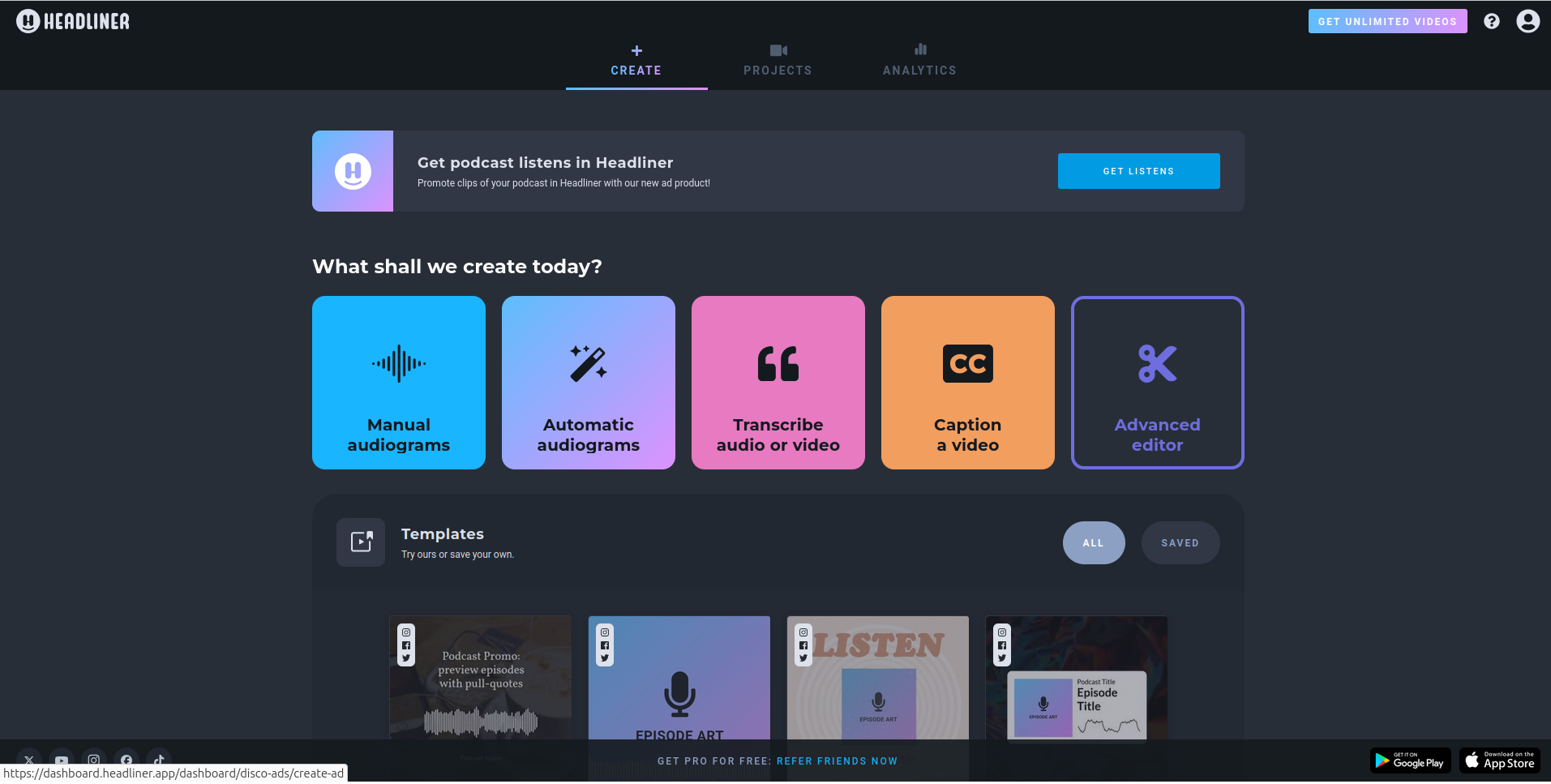
Initially launched as a service to create playable snippets of podcasts (audiograms) for social media, Headliner has added various new features over the years to become a vital tool for podcast promotion.
With around 1.3 million users, Headliner has an editable transcription tool called Eddy, which can create clips, captions, and even AI blog posts. Another tool, Disco, embeds contextually relevant podcast episodes into your website, aiming to convert visitors into listeners. Headliner also has a Podcast Promo tool that is essentially an advertising tool for your podcast, putting it in front of other users of Headliner.
The Audiograms tool is just as important as these features, and all are easy to use. Headliner’s web interface guides you through generation, and in most cases requires little more than uploading an image. Audio is imported via your podcast’s RSS feed.
Payment options for Headliner include a free plan that creates 5 unwatermarked videos per month, 350MB of video upload space, and even auto posts podcasts to YouTube. For $7.99/month, Headliner gives you a Basic plan with 10 unwatermarked videos, 500 MB of video space, support for branded templates, and more. You can also pay $19.99/month for the Pro plan, with unlimited videos, unlimited podcast feeds, 15 hours of transcriptions every month, and various other leveled-up benefits. Paid options have a free trial.
Note that Headliner runs in any browser, and offers a mobile app for Android and iOS.
OpusClip

Designed as a promotional tool for video creators, OpusClip is perfect for video podcasters looking for a quick and easy way to snip, clip, and package highlights from their show into an easily shareable video.
Powered by OpenAI, OpusClip aims to turn long videos into short videos and can publish on social networks with a single click. This tool saves a lot of effort in editing and is free to start using.
Using the tool is simple. After signing in, you paste a video URL or upload a file, and wait while the AI editor chops the video into 10 clips. Not all will suit the purpose of your promotion, but all should be usable. They’re presented for you, ready to use, complete with a rating for how well the clip is likely to do on social media. You can also open the editor to start tweaking the clip, the audio, and the captions before sharing or downloading.
OpusClip’s free option gives you 60 minutes of processing a month, in 1080p quality, with AI captions, but clips are watermarked and can only be exported for 3 days. The Start option is $15/month and gives 150 processing minutes a month, AI captions in 20+ languages, autoposting to YouTube shorts, TikTok, and Instagram Reels, and adds an editor. It also removes the watermarking. For the $29/month Pro plan, you get 3600 processing minutes per year, support for two users, and improved features like an AI-generated B roll, a choice of aspect rations, exporting to Adobe Premiere Pro and Da Vinci Resolve, and even social media scheduling. Both paid options have a free trial.
AI transcription tools
Happyscribe
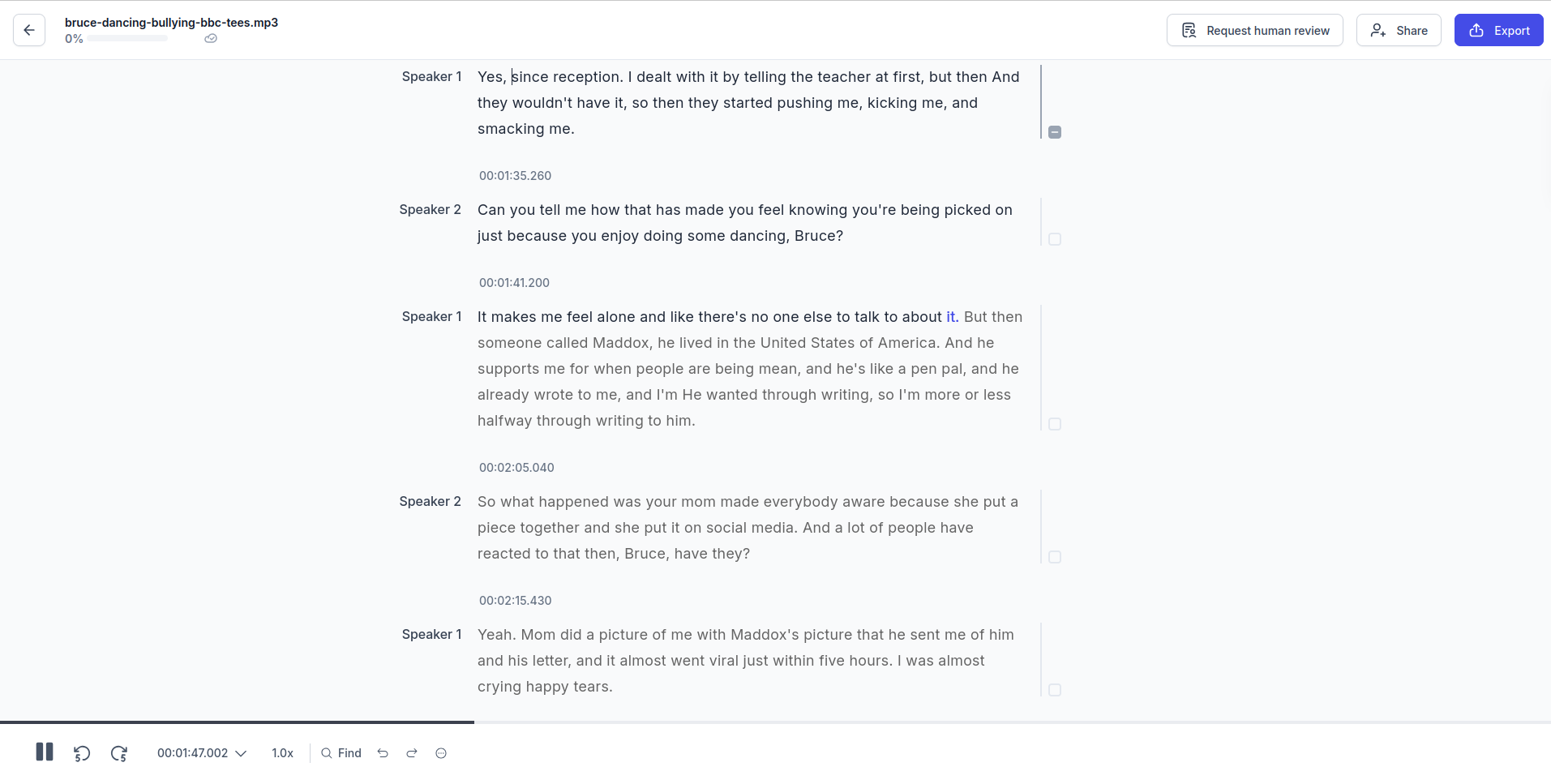
If your podcasting workflow is pretty advanced and you’re just looking for a transcription tool, Happyscribe can help you out. This uses AI (or you can request a human transcription at $1.50/minute) to transcribe an audio file. You can also request a human reviewer after the event.
You simply upload the file in question, wait, and then download the transcription. You can edit it to fix incorrect spellings and convert the transcription to subtitles.
While free to try, Happyscribe has paid tiers. For $10/month you get 120 minutes of transcriptions, which can be exported in Word or TXT, and subtitles in SRT and MP4 format, watermark-free. For $17/month, the Pro plan gives you 300 minutes, the option of a PDF export, and subtitles in additional formats, including XML. The Business plan is $29 and accommodates 600 minutes, three users (seats), role management, style guides, and premium support.
Restream.io

Restream is another good option for an AI transcription tool. This tool lets you simply upload a recording and wait for the transcription, which you can then download for use on your site, in the podcast shownotes, whatever.
However, Restream also offers a paid tool for managing video streaming, also known as live podcasting. This doesn’t rely so much on AI, but it’s worth knowing about.
Restream’s paid options are $19/month for the Standard option (no watermark, three channels supported, unlimited recordings, personal graphics, and uploading and streaming. The Professional plan is $49/month, with five channels, unlimited recordings and downloads, full HD video, and the option of two users. Businesses can get the $239/month plan, with eight channels, 30 days of storage, a web player, and a producer mode.
But remember, its transcription tool is free.
FAQs
What is podcasting?
Podcasting is the process of producing podcasts. At its most basic, it involves recording and uploading audio, making it available to share via Apple Podcasts, Spotify, and other services.
Podcasts can be anything from free form discussion to polemics, scripted drama and comedy to scripted non-fiction.
Over the years, podcasting has become more complicated, as listener tastes have evolved. While podcast audio is now expected to be high quality, some shows are also produced in video form, or ignore the traditional audio medium altogether.
Unsurprisingly, video podcasts require a more complex production process, relying not just on high quality mics and recording equipment, but cameras and lighting.
What are AI tools?
You’ve probably heard about Artificial Intelligence and how its various applications can be used to improve processes and workflows. You have probably also encountered generative AI in the form of fake videos, graphics, and audio, all generated by computer rather than created by a human.
The term “AI tool” covers each of these uses, and others besides. If a computer program has been trained on a Large Language Model (LLM) dataset, and the program is then used to generate media or offer interpretations based on that data, then it can be said to be an AI tool.
How do you use AI for podcasting?
You have various options for podcasting using AI tools.
They can be integrated into your workflow to save time, help with improving the audio quality, and even improve your social media interactions. Generative AI can be used to produce logos, episode art, and perhaps produce voices for you. This can be useful from an accessibility point of view; it may also helpful to produce quotes in an AI voice for inclusion in your podcast that is different enough from your own.
AI tools can also be used for compiling shownotes, specifically for transcriptions. One of the best uses of AI for podcasting is in show promotion. Various tools are available that can slice and dice audio and video podcasts into clips, useful for sharing on social media, giving your potential audience a sneak peak and helping them to decide whether to watch, listen, or even subscribe.
Whether you’re a fan of generative AI or simply appreciate the improvements AI can make to processes and data analysis, these technologies are already being incorporated into podcast production.
Christian Cawley has extensive experience as a writer and editor in consumer electronics, IT and entertainment media. He has contributed to TechRadar since 2017 and has been published in Computer Weekly, Linux Format, ComputerActive, and other publications. Formerly the editor responsible for Linux, Security, Programming, and DIY at MakeUseOf.com, Christian previously worked as a desktop and software support specialist in the public and private sectors.

